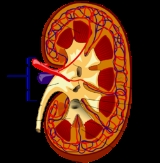
Renal pyramids
Encyclopedia
Renal pyramids are cone-shaped tissue
s of the kidney
. The renal medulla
is made up of 7 to 18 of these conical subdivisions (usually 7 in humans). The broad base of each pyramid faces the renal cortex
, and its apex, or papilla
, points internally. The pyramids appear striped because they are formed by straight parallel segments of nephron
s.
Biological tissue
Tissue is a cellular organizational level intermediate between cells and a complete organism. A tissue is an ensemble of cells, not necessarily identical, but from the same origin, that together carry out a specific function. These are called tissues because of their identical functioning...
s of the kidney
Kidney
The kidneys, organs with several functions, serve essential regulatory roles in most animals, including vertebrates and some invertebrates. They are essential in the urinary system and also serve homeostatic functions such as the regulation of electrolytes, maintenance of acid–base balance, and...
. The renal medulla
Renal medulla
The renal medulla is the innermost part of the kidney. The renal medulla is split up into a number of sections, known as the renal pyramids. Blood enters into the kidney via the renal artery, which then splits up to form the arcuate arterioles. The arcuate arterioles each in turn branch into...
is made up of 7 to 18 of these conical subdivisions (usually 7 in humans). The broad base of each pyramid faces the renal cortex
Renal cortex
The renal cortex is the outer portion of the kidney between the renal capsule and the renal medulla. In the adult, it forms a continuous smooth outer zone with a number of projections that extend down between the pyramids. It contains the renal corpuscles and the renal tubules except for parts of...
, and its apex, or papilla
Renal papilla
In the kidney, the renal papilla is the location where the medullary pyramids empty urine into the minor calyx. Histologically it is marked by medullary collecting ducts converging to form a duct of Bellini to channel the fluid. Transitional epithelium begins to be seen.-Role in disease:Some...
, points internally. The pyramids appear striped because they are formed by straight parallel segments of nephron
Nephron
The renal tubule is the portion of the nephron containing the tubular fluid filtered through the glomerulus. After passing through the renal tubule, the filtrate continues to the collecting duct system, which is not part of the nephron....
s.

